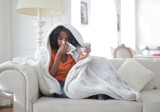
Ah, the fall.
It's a magical time of the year. The cold yet refreshing crisp air. The vibrancy of red and gold leaves on the trees and underfoot. Well-being boosting fall walks. And pumpkin spice everything, everywhere.
But for many, the fall brings something far less enjoyable: fall allergies.
While you may get away without hay fever spoiling your spring and summer, perhaps you’re not so fortunate when the leaves start to drop. So when you're thinking about the wonderment of fall and even beginning to look forward to the holidays, the last thing you want to do is deal with endless sneezing, itchy eyes, a runny nose, and any other allergic reactions the fall inflicts.
And worst of all, anyone who doesn't suffer from fall allergies probably thinks hay fever is done with and has no idea what you're going through!
Let’s explore everything you need to know about fall allergies.
Fall Allergies vs. Spring Allergies: What’s the Difference?
The main difference is in the triggers.
That's why you can feel completely fine during the summer but then lousy as the weather changes – and not just because you don't like the cold and dark!
While spring allergies are typically triggered by tree pollen, grass pollen, and blooming flowers, fall allergies show themselves thanks to different culprits.
What are the Most Common Fall Allergy Triggers?
Ragweed
Ragweed is the most common – and notorious – of the fall allergens. Perhaps worst of all, WebMD says that if you suffer from spring allergies, there's a 75% chance you're also allergic to ragweed.
That’s likely because ragweed releases pollen, starting from mid-to-late August and often continuing right through the fall until you start seeing frost on the ground.
And living far from the country or anywhere that ragweed grows is no defense. The Environmental Protection Agency explains that ragweed plants can produce up to a billion pollen grains, and the wind can carry them hundreds of miles. And if you live in the north of the country, climate change is also making the ragweed pollen season longer!
Symptoms of a ragweed allergy are similar to spring pollen allergies. If you're allergic to ragweed, expect to experience sneezing, a runny or stuffy nose, itchy eyes, and a scratchy throat.
Mold Spores
Mold thrives in cold and damp environments, so you must be extra alert during fall and winter. Mold spores can affect you indoors and outdoors, too, making it even tricker to avoid their menace.
The beautiful piles of colorful leaves you see at the end of your driveway - an ideal breeding ground for mold spores. Mold develops indoors during the colder months because of the moisture trapped inside. If it’s not too cold, keeping your windows even a little open can make a significant difference and help moisture escape. Remember to wipe condensation from windows in the morning, too.
Mold allergy symptoms are often similar to those you’ll experience if you’re allergic to pollen, with added respiratory symptoms such as coughing, wheezing, and shortness of breath, all of which can feel worse due to the cold.
Dust Mites
Dust mites are present throughout the year; in fact, they should get more attention when we talk about spring allergies, given how much pollen is likely present in any household dust during the warmer months.
But there doesn’t need to be pollen in your dust for you to be allergic to it – you can be allergic to dust mites themselves.
And those dust mites become increasingly problematic during the fall when we spend longer indoors. These pesky things thrive in the warmth of our homes and especially in the places we seek sanctuary and comfort, like our beds. When we close our windows and turn on the heating, we trap dust mites inside and make them feel right at home.
Dust mite allergies typically lead to sneezing or a runny or stuffy nose but can also present as asthma-like symptoms.
Treating Fall Allergy Symptoms
You know what allergies to look out for. And you know the tell-tale symptoms that will show you you’re experiencing an allergic reaction.
Now let’s deal with them.
Option 1: Allergy Medications
Over-the-counter allergy medications are a great first line of defense against fall allergies; here are three options that will help you cover the most common symptoms.
- Try these Zaditor Eye Itch Relief Antihistamine Eye Drops to enjoy up to 12 hours of relief and protection from common fall allergens causing itchy and uncomfortable eyes.
- This Benzedrex Nasal Decongestant Inhaler will serve you well during the fall as well as the winter months as you start to experience colds, and can be used every couple of hours as needed.
- Antihistamines aren’t just for spring hay fever! These Foster & Thrive Allergy Relief Tablets are ideal for dealing with common pollen allergies and triggers all year round.
Option 2: Natural Remedies
If you prefer natural remedies, you can:
- Make your own saline rinse to flush allergens from your nose, or buy a product like this Premier Value Squeeze Saline Nasal Wash that gives you the solution and the means of easily using it.
- Consider taking butterbur extract, which the British Medical Journal found to be just as effective as over-the-counter antihistamines for relief from hay fever symptoms, and all without the side effects of taking medication!
- Try taking local honey. It’s a hay fever and anti-allergy tip as old as time. Some swear by it, others believe it’s nonsense. It won’t hurt to try it and see if it works for you.
Option 3: Preventative Measures
Prevention is always better than cure, especially when it comes to allergies.
Here are four things you can do to reduce your exposure to allergens this fall:
- Monitor pollen counts. TV weather reports will stop mentioning pollen at the end of the summer, but your weather app will still feature pollen counts. The standard weather app on your smartphone should also provide a pollen breakdown, helping you to understand what specific types of pollen are around, which may also help you better understand your allergies and triggers.
- Clean your home. Regular vacuuming and cleaning will reduce the presence of dust mites and kill mold spores before they even become visible. Consider buying a vacuum with a HEPA filter for more effective trapping of allergens.
- Use a dehumidifier to help discourage mold growth – aim for an indoor humidity level below 50%.
- Shower after participating in any outdoor activities and change your clothes when you come home so you can escape any pollen or mold spores that may have clung to you. Ensure your clothes go in a closed laundry bag or basket – don't leave them on the floor, from where all these allergens can spread!
Option 4: Allergy Shots
If your allergies are severe, consider getting allergy shots.
This treatment, called immunotherapy, involves receiving regular injections of small amounts of the allergens that trigger your symptoms so that your body becomes desensitized to them, reducing your symptoms and reactions over time.
You will typically only be offered immunotherapy if you’re particularly sensitive to several allergens, so keep a diary of your triggers and symptoms before visiting your clinician if you think you may need to go down this route.
Enjoying Fall Without the Allergy Symptoms
Don’t let your allergies prevent you from enjoying the wonderment of the fall.
Follow the tips we've shared here, know your specific personal allergies and triggers, and you'll be all set to make the most of everything autumn has to offer.







